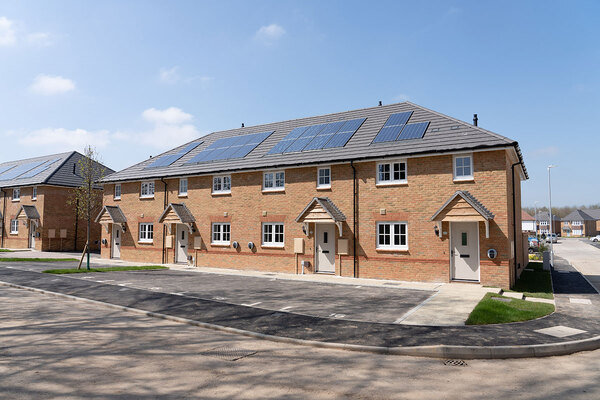Making a point
Inside Housing’s Grant Britain Homes campaign is acting as a cheerleader for continued government funding for affordable housing. Chloë Stothart explains why the chancellor should be grant subsidy’s number one fan
If there was a show of hands around the cabinet table, most ministers would agree there is a need for more affordable housing. When the issue of grant is raised, however, the outcome becomes less certain.
Why should new affordable housing require grant funding though? Neither the coalition, nor the opposition parties have made any commitment to providing more grant because, in the short term, it is more expensive, so alternative forms of subsidy are being considered. A world without grant has a lot of downsides, however, which is why Inside Housing launched its own Grant Britain Homes campaign a fortnight ago.
Here, we cheer the benefits of grant funding over some of the other forms of subsidy, including a few being considered by the Treasury.
Discounted land
Since land is usually the most expensive component of housing, cheap land is a very useful subsidy. Councils in particular often provide land cheaply to housing associations or sometimes build on it themselves.
However the sites may not be where housing is needed and the sites released by the government have tended to be large plots which take time to build out. Grant allows landlords to buy ‘the site that is right’, says Adam Barnett, investment policy officer at the National Housing Federation.
He adds that discounted land is also less effective in areas where land is cheap and that funding pressures on public sector landowners could lead them to charge higher prices for their sites.
Ultimately, according to Abigail Davies, assistant director of policy and practice at the Chartered Institute of Housing, grant has the benefit of being more straightforward and flexible. For example it takes time to sell assets and cheap land may not be in the right places to meet need or demand. ‘Grant helps speed and volume [of development],’ she says, meaning more people can be housed.
Flexible rent levels
The most recent round of affordable housing funding in England was predicated on landlords charging ‘affordable’ rents on new homes of up to 80 per cent of the market rate but with reduced grant levels.
Now the Treasury is mulling allowing developing housing associations to charge higher rents than non-developing landlords (Inside Housing, 7 June). Could the ability to charge higher rents provide a better subsidy for social house building? In lieu of grant, landlords are having to find other sources of finance, such as loans or bonds, to provide the upfront funding to build new homes. While there are arguably associations with the capacity to borrow more, they will not be able to do so indefinitely.
Additionally, rental income is less secure than it once was: housing benefit will become part of a single welfare payment made to the tenant, not the landlord, from October under universal credit. It will be linked to the consumer price index which tends to grow more slowly than market rents.
‘We would ideally have a level of grant, which implies less risk,’ says Robert Grundy, a director at property consultancy Savills, referring to the risks of lost rent through the housing benefit changes and of higher borrowing. In places where the difference between social and market rents is small, there is less potential to generate money through rent rises, while landlords in expensive areas fear tenants would be unable to find the extra cash.
About two thirds of tenants in the social sector claim housing benefit, according to the NHF, so increased rents also mean the taxpayer foots a bigger bill. This is shown by studies from both the National Audit Office and 66,000-home housing association London & Quadrant, which found that affordable rent has lower upfront costs than the previous grant regime but is more expensive for the government over a 30 or 40-year period.
However, there may be scope to raise rents for some tenants who do not claim housing benefit. ‘You have to be careful about increasing rents at rates that make it uneconomic for people to go to work,’ says Mr Grundy. ‘The rent rises would be quite modest amounts but when taken together they could deliver additional borrowing capacity.’
Cross-subsidy
Most large housing associations already build homes for outright sale and some also rent properties at open market rates too.
Some, especially in areas where property prices are high, have sold valuable homes and used the proceeds to develop larger numbers of homes in cheaper areas.
‘It is right to consider it but it is wrong to get carried away with the volume that could be delivered through the sale of high-value assets,’ says Savills’ Mr Grundy. ‘You have to think about the impact on tenants.’
He adds that the rights of tenants living in the property that may be sold have to be balanced against those waiting for housing who will benefit from the new development.
Mr Barnett at the NHF adds: ‘There is a massive housing crisis and a lot of need for affordable homes and cross-subsidy won’t replace grant.’ It takes time to sell assets and, as the credit crunch demonstrated, there are risks to open market development.
Section 106
Historically a large portion of affordable housing has been provided through planning gain agreements with private developers. Section 106 agreements still provide about half of affordable housing in England, although the proportion has fallen and requirements have been relaxed to make schemes viable as overall house building has dropped in recent years to 108,190 in England. Section 106 is also likely to produce 10,000 fewer affordable homes as a result of new rules allowing developers to renegotiate some agreements.
‘In recession section 106 is more dependent on the market and more vulnerable whereas grant does not have that vulnerability,’ says the NHF’s Mr Barnett. In Scotland section 75 provides about a third of affordable housing.
The big house builders are now enjoying healthy profit margins so is it time to ask them to supply more affordable housing? Savills’ Mr Grundy urges caution: house builders may be making more money but they are still not building many homes so getting them to pay for more affordable housing could lead them to produce even less overall.
‘We are at a delicate point in market between volume and affordable housing. My feeling is the policy now is about getting volume moving with less focus on what tenure it is,’ he says.
Of course, all these methods of subsidy have their pros and cons. Grant can help overcome these shortcomings so the sector can house those in need.
Campaign aims: Grant Britain Homes
Inside Housing’s Grant Britain Homes campaign calls for:
- a commitment from UK government to provide grant funding to subsidise the development of sub-market rented homes;
- in England, to make this commitment long-term - at least four years - to allow housing providers to make their plans for building more homes with the certainty of support;
- in return, social landlords will commit to helping reduce the housing benefit bill by delivering more homes at sub-market rents and helping boost employment in their communities.









